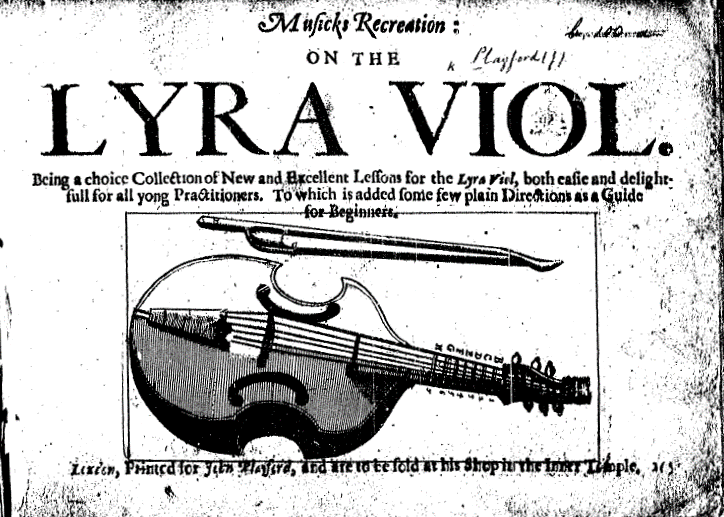- Lyra viol
Infobox Instrument
name= Lyra viol
names=
classification=
*Bowed string instrument
range=
related=
*Viol [

John Playford 's "Musicks recreation on the lyra viol"] The lyra viol is a small bassviol , used primarily inEngland in theseventeenth century .While the instrument itself differs little physically from the standard consort viol, there is a large and important repertoire which was developed specifically for the lyra viol. Due to the number of strings and their rather flat layout, the lyra viol can approximate
polyphonic textures, and because of its small size and large range, it is more suited to intricate and quick melodic lines than the larger types of bass viol.The lyra viol has been favorably compared to both the
lute and theviolin , byTobias Hume and Roger North respectively. The name lyra viol came into use because the playing style of bowedchord s is similar to that of thelirone .Frank Traficante. "Lyra viol", "Grove Music Online", ed. L. Macy (accessedMay 20 2006 ), [http://www.grovemusic.com/ grovemusic.com] (subscription access).]tructure
The structure of the lyra viol has been fluid throughout its history. In seventeenth century England
sympathetic strings were added. This may have led to the development of thebaryton , but it was not a lasting development for the lyra viol. The most common lyra viols had six strings, but there were also viols with four and seven strings.John Playford describes the lyra viol as the smallest of three types of bass viol: the consort bass,division viol , and lyra viol.Christopher Simpson wrote that the strings on the lyra viol were lighter and the bridge flatter than those on the other bass viols. The strings were also closer to thefingerboard than they were on the consort bass. These modifications were probably in part to make playing chords easier. The first description of bowed polyphonic music for the viol is in a treatise byJohannes Tinctoris , and the first development of its repertoire can be traced back toSylvestro di Ganassi dal Fontego in the mid-sixteenth century.Despite these differences in structure, the lyra viol is not significantly different from other bass viols, and lyra viol music can be played on any bass viol.
Repertoire
Some of the best English composers of the seventeenth century wrote pieces for the lyra viol, or even entire anthologies. These composers include John Cooper, John Jenkins,
Christopher Simpson ,Charles Coleman , andWilliam Lawes . The types of pieces written for the instrument range from single melodic lines, to lyra trios and duets, lyra with other instruments, and lyra as accompaniment for a song. Almost all music for the lyra viol is written intablature , mainly French lute tablature, but also some Italian and a little bit of German lute tablature.Polyphonic music is idiomatic for the lyra viol. It is most similar to lute music, as the number of voices can change within a piece, unlike harpsichord music where the number of voices tends to stay consistent. Since the lyra viol is bowed, all chords must be formed using adjacent strings. This leads to very close harmonic voice leading, which may also be the reason for the frequent unison double stops in lyra viol music, perhaps also intended to imitate the double course of strings on the lute. Since all the chords must be formed using adjacent strings,
scordatura tunings are the rule rather than the exception. Almost 60 different tunings from the seventeenth century have been found. They tended to be formulated so as to put the most important notes on open strings, and were composed in sets of pieces, so that players would not have to retune too frequently.Another technique for the lyra viol was the ornament or grace known as the "thump", where the player plucks the open strings with the fingers of the left hand. This may have been the forerunner of the technique of plucking the sympathetic strings on the baryton. The viol may also have sometimes been held in the lap and played lute-style. The first reference to this practice is in Tobias Hume's "The First Part of Ayres" (1605), which was written a number of years before
Claudio Monteverdi 's "Combattimento di Tancredi e Clorinda" (1624) which is frequently cited as the earliest source ofpizzicato . Hume's work also discusses playingcol legno on the lyra viol.References
Wikimedia Foundation. 2010.
